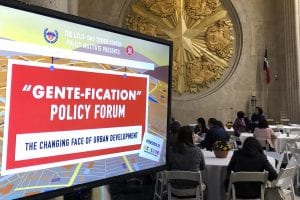 The SMU Tower Center and Latino Center for Leadership and Development co-hosted a policy forum discussing “gente-fication” and various policy solutions that could reduce the impact of the rising costs of housing and amenities for low-income locals. HCM Tower Scholar Destiny Rose Murphy wrote about what she learned.
The SMU Tower Center and Latino Center for Leadership and Development co-hosted a policy forum discussing “gente-fication” and various policy solutions that could reduce the impact of the rising costs of housing and amenities for low-income locals. HCM Tower Scholar Destiny Rose Murphy wrote about what she learned.
By Destiny Rose Murphy:
If you have spent any major portion of your life in the city gentrification is probably not a term you’re unfamiliar with. Dallas residents especially know what this word means. It’s easy to forget the family owned businesses that were pushed out by the art studios, and about those who lived in the now-chic exposed brick buildings back when they were just called “poorly insulated.” In most cases, the ethnic history of such regions is swiftly forgotten; after all, how many people reading this know that the shiny area called Uptown was called Little Mexico just 25 years ago?
But soon Dallas will be up against a new problem: gente-fication.
Gente-fication Explained
Gente, the Spanish word for “people,” is used to distinguish gente-fication from gentrification as a process undertaken by successful members of the Latino community who return to their homes, the working-class barrios where they were raised, with their newly-gained upward mobility. Bringing with them desires for upper-class amenities, which create new and more expensive markets in the area, these returned-residents raise the cost of living and thereby cause what can feel like gentrification affects (higher property taxes and less affordable housing and resources).
However, thanks to the cultural background of the gente, flourishing ethnic cultures are not necessarily destroyed in this process. And, according to the panelists, if executed with care gente-fication can lead to a rising socio-economic class in barrios that does not sacrifice the heart of the community.
Tower Center Postdoctoral Fellow Jennifer Cook moderated a three-man panel: Alfredo Huante, who presented his extensive work on gente-fication in the LA area, Hon. Henry Cisneros, former U.S. Secretary of Housing and Urban Development and Mayor of San Antonio, and Mike Koprowski, Executive Director of Opportunity Dallas.
The Process of Gentrification
The American city is booming. The country is becoming an economy of services, and these services must be performed in areas with a gente large enough to pay to keep these services afloat. So, we move inwards; we coalesce; we build apartments and buy bikes and expect good takeout food.
During the Great Recession, when cities hollowed out and many fled to the suburbs and farther, often it was the poor who remained and took advantage of the then-affordable housing. Now that we, and by we I mean middle and upper-class Caucasians, are moving back with our avocado toast (as Mr. Huante put it), we are pushing out those who weathered the storm in the cities. Gentrification is smothering cultures that flourished in the places that were once abandoned.
What can Dallas do?
Dallas will face gente-fication because Dallas has an ever-rising Latino community. Gente-fication will displace other minority groups, who will face their own “-fications” in turn, with gentrification always on the horizon for everyone. The panelists offered a few possible tools for Dallas to use in the future to alleviate the impact of these processes:
- Algorithms already exist that can identify at-risk neighborhoods; these could be used to defend against the dangers of gentrification before they begin.
- Once communities are identified, assemblies and town halls can be held to notify local populations and get their feedback on their needs throughout the process.
- Private, local, and state funding can be funneled toward assisting local populations, as has been done in Atlanta, where some residents are having their rising property taxes paid for.
- Assisted exit strategies should be developed so that those community members who want to move, instead of being forcibly displaced, have the ability to.
Sec. Cisneros nearly rose from his chair as he spoke of the need to listen to grassroots and in-community organizations, genuine voices who could set a proper rate for gente-fication and gentrification in order to avoid the displacement of those who can’t afford new property taxes. When an audience member asked a question about cost-effective measures for combating gentrification Mr. White, too, leaned dangerously forward as he denounced the idea of reaching for low-hanging fruit regarding such an issue. “Go big or go home,” he said.